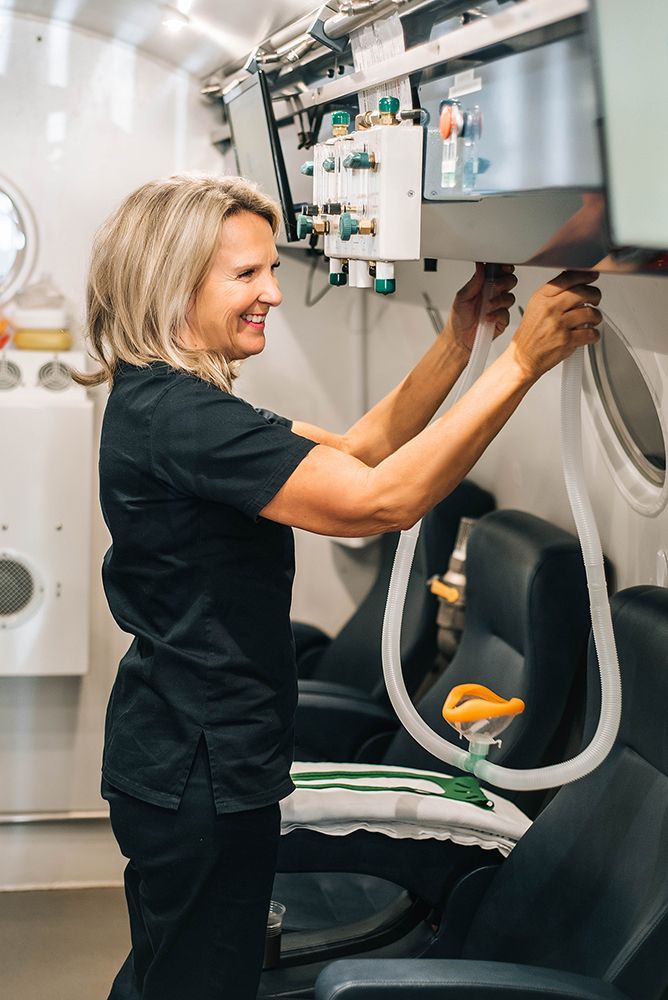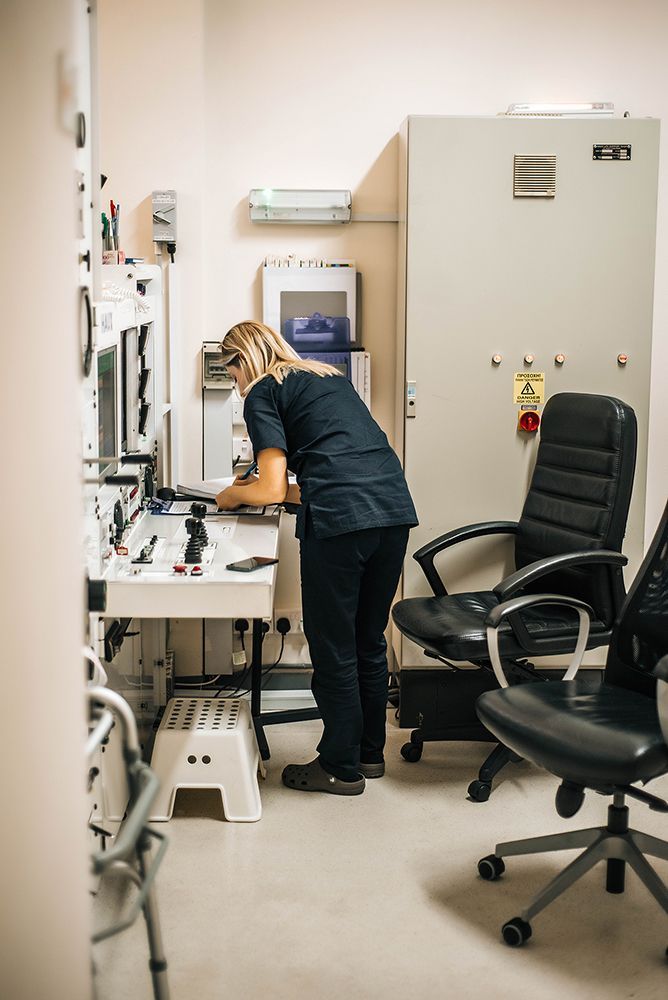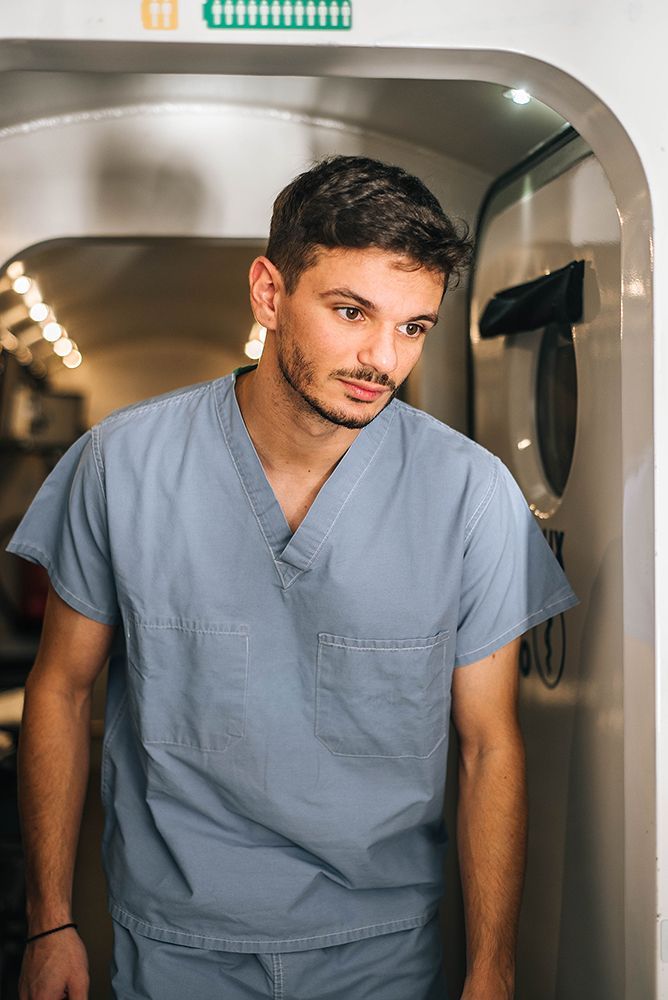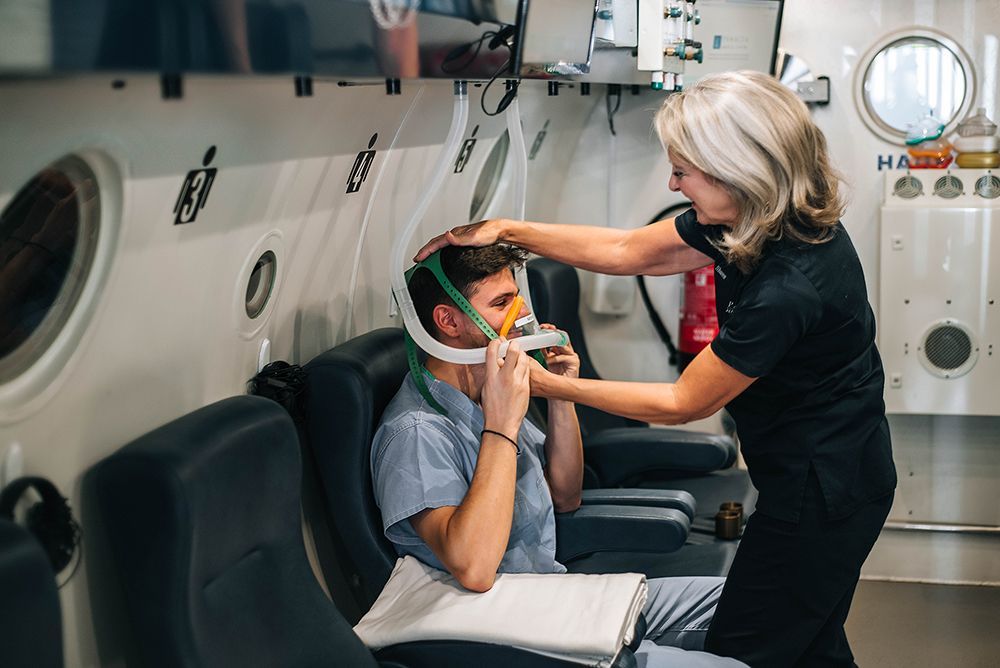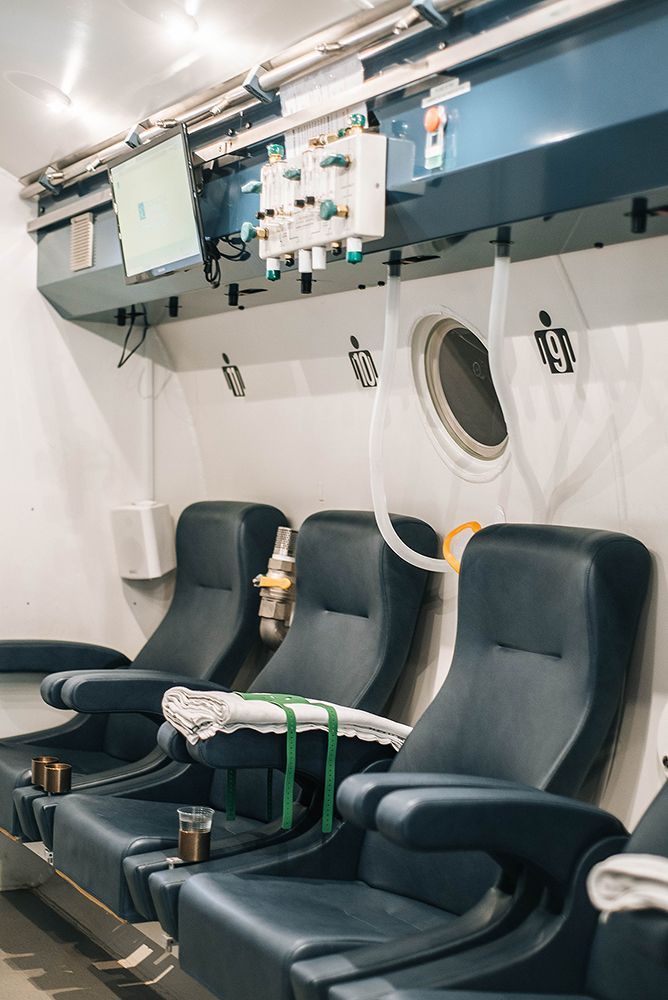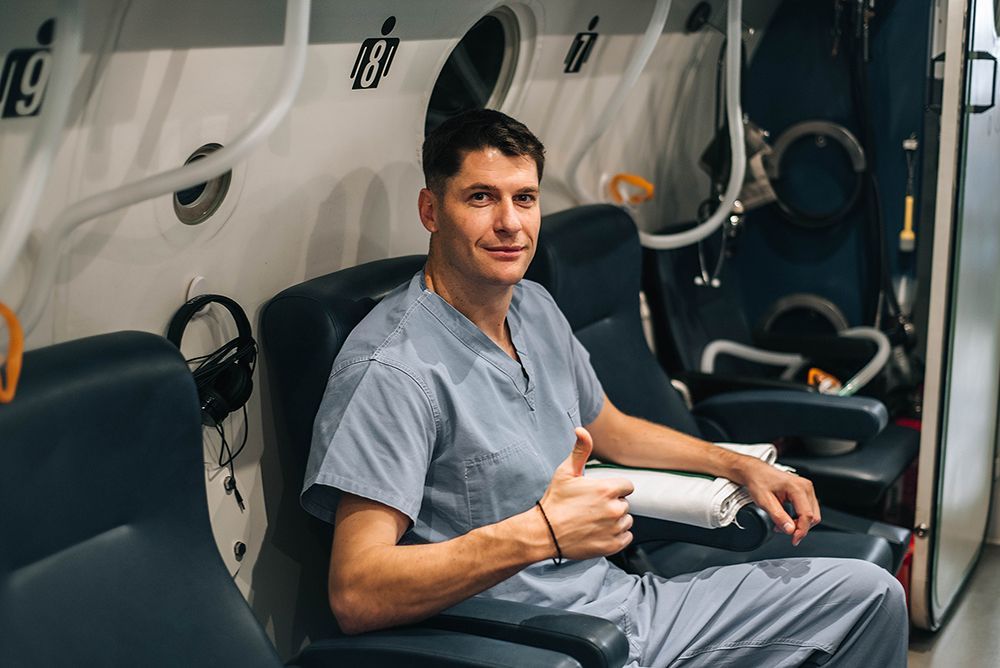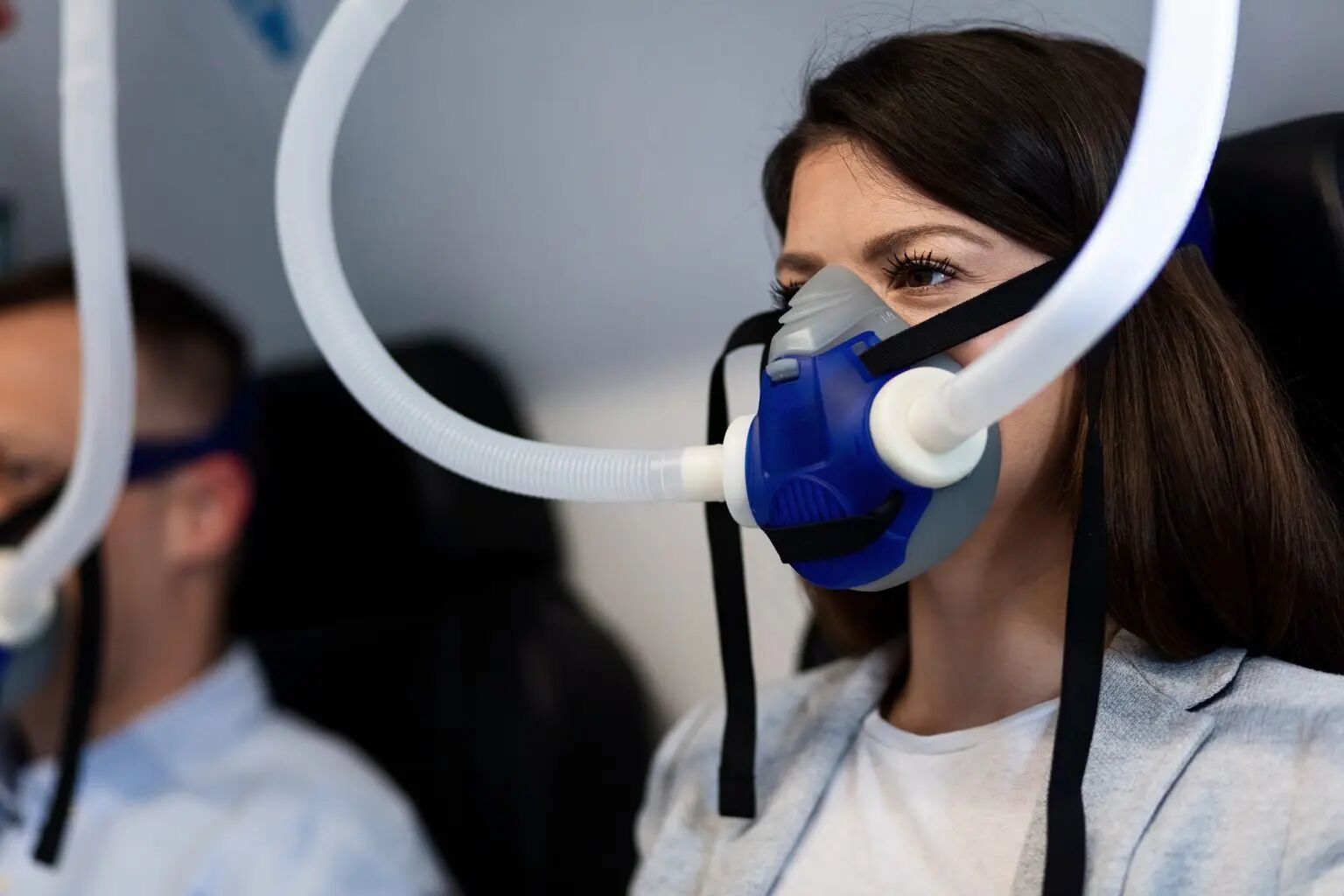Understanding Hyperbaric Oxygen Therapy: A Comprehensive Overview
The air you breath on a daily basis usually contains 21% oxygen
Oxygen therapy involves breathing 100% oxygen in a pressurized environment called a Hyperbaric Chamber. Hyperbaric oxygen therapy is a well-established treatment for decompression sickness, a potential risk of scuba diving. However, it is now being used to treat many other conditions like Long Covid, Lyme disease, MS, Fibromyalgia, Diabetic ulcers etc.
An interesting fact is that Hyperbaric Chambers Precede the Discovery of Oxygen. Although hyperbaric therapy has been used since 1662, oxygen wasn’t discovered until 1775 by English scientist Joseph Priestley.
In a hyperbaric oxygen therapy chamber, the air pressure is increased 2 to 3 times higher than normal air pressure. Under these conditions, your lungs can gather much more oxygen than would be possible breathing pure oxygen at normal pressure. We end up putting so much oxygen into your system it now goes into the plasma as well as the red blood cells.
While possible side-effects of prescription medication range from heart conditions to mental chemical imbalance and loss of muscle coordination, hyperbaric oxygen therapy has been proven to pose minimal risk to users, regardless of age and physical state.
White papers being published in Israel are slowing that if we can put the body into am oxygen rich then oxygen poor environment, they body then release of substances called growth factors and stem cells, which promote healing. This is why we run with 3 20 minutes sessions with 2 air breaks rather than the previous 30 minute session with a single air break.
This extra oxygen also helps fight bacteria.
Your body's tissues need an adequate supply of oxygen to function. When tissue is injured, it requires even more oxygen to survive. Hyperbaric oxygen therapy increases the amount of oxygen your blood can carry. With repeated treatments, the temporary extra high oxygen levels encourage normal tissue oxygen levels, even after the therapy is completed.
Hyperbaric oxygen therapy was first used in the U.S. in the early 20th century.
The therapy was tried again in the 1940s when the U.S. Navy used it to treat deep-sea divers who had decompression sickness. By the 1960s, the therapy was also used to treat carbon monoxide poisoning.
Today, it's still used to treat sick scuba divers and people with carbon monoxide poisoning, including firefighters and miners.
How does HBOT work?
HBOT helps wound healing by bringing oxygen-rich plasma to tissue starved for oxygen. Wound injuries damage the body's blood vessels, which release fluid that leaks into the tissues and causes swelling. This swelling deprives the damaged cells of oxygen, and tissue starts to die. HBOT reduces swelling while flooding the tissues with oxygen. The higher pressure in the chamber increases the amount of oxygen in the blood. HBOT aims to break the cycle of swelling, oxygen starvation, and tissue death.
HBOT helps block the action of harmful bacteria and strengthens the body's immune system. HBOT can disable the toxins of certain bacteria. It also increases oxygen concentration in the tissues. This helps them resist infection. In addition, the therapy improves the ability of white blood cells to find and destroy invaders.
HBOT also encourages the formation of new collagen and skin cells. It does so by encouraging new blood vessel to grow. These attract and stimulate endothelial cells needed for healing.
Many Professional Athletes and celebrities use Hyperbaric Chambers
Professional athletes are amongst those celebrities utilizing hyperbaric therapy - but not necessarily for its anti-aging qualities. Olympic swimmer Michael Phelps are also advocates for the regenerative qualities of hyperbaric therapy, detailing its ability to cut down on recovery time by increasing blood flow to damaged tissue and strained muscles.
What happens during HBOT
Our chamber is very similar to a private jet and can comfortably seat 11 patients. You will be joined inside always by a fully Trained hyperbaric Tender, who is there during the whole treatment process. Once we start to raise the pressure your ears may feel plugged, very much like take-off and landing in a plane or going up to the mountains. The tender will show you all the different ways to “pop" yours ears during the decent.
When you get to the treatment depth the Chamber operator will instructed the Tender to place all the patients on O2, so the tender will help you fit your mask and then you will breather normally for 20 minutes before getting an air break so you can have a drink and a stretch if you like.
Now your plasma carries the extra oxygen throughout the body, infusing any injured tissues that need more oxygen so they can start healing.
As mentioned, before you will have 3 sessions of 20 minutes and 2 air breaks before we make our assent back to the surface. This is when we release the extra air we have added so bring the chamber back to normal levels.
When a session is done, you may feel lightheaded. Some patients feel tired after the session and we recommend having a nap if you can as the body now wants to use all this extra Oxygen to fix things, your body is very much like a computer it can only update in sleep mode …..
Because HBOT is gentle and non-invasive in nature, it is a powerful treatment when used on its own, however combining it with other therapies is beneficial and our doctors here will Taylor a treatment plan based on your individual signs and symptoms. It is also the reason we offer a free 15 minute consultation either in person or over WhatsApp.
Now lets go a little deeper into the conditions that HBOT can hep with
Hyperbaric Oxygen Therapy currently have 14 conditions that are FDA approved for treatment. The newest one received approval on October 8, 2011. These FDA approved conditions include:
• Air or Gas Embolism
• Carbon Monoxide Poisoning
• Clostridial Myositis and Myonecrosis (Gas Gangrene)
• Crush Injuries, Compartment Syndrome and Other Acute Traumatic Ischemia
• Decompression Sickness
• Arterial Insufficiencies, such as Central Retinal Artery Occlusion
• Severe Anemia
• Intracranial Abscess
• Necrotizing Soft Tissue Infections
• inflammation or swelling of bone tissue
• Delayed Radiation Injury (Soft Tissue and Bony Necrosis)
• Compromised Grafts and Flaps
• Acute Thermal Burn Injury
• Idiopathic Sudden Sensorineural Hearing Loss
Because Hyperbaric Oxygen Therapy is still gaining in popularity and usage, clinical studies for all the potential conditions it may benefit have yet to meet FDA standards. This does not, however, mean that Hyperbaric Oxygen Therapy does not help or treat these conditions. In many cases, there are studies that show promising results and benefits already, but they are not enough.
The term “FDA Approved” is something you may be familiar with. In contrast, a drug or treatment receives the term “Off-Label” when doctors use it to treat a condition that is not FDA approved. Hyperbaric Oxygen Therapy treatment is only approved for the 14 different medical conditions mentioned. However, physicians and researchers see positive results in many more conditions. Therefore, we treat off-label conditions on a daily basis. This practice is not new to medicine. It would amaze you at how many conditions find relief through off label use every day.
Off Label treatments that Hyperbaric Oxygen Therapy helps with, unfortunately not covered by most insurances.
• Alzheimer’s
• Autism
• Cancer
• Cerebral Palsy
• Fibromyalgia
• Lyme Disease
• Migraines
• Mold Exposure and Toxicity
• Multiple Sclerosis
• Post-Traumatic Stress Disorder
• Stroke
• Traumatic Brain Injuries
• Wound Care
Alzheimer’s
Drug therapy is the main strategy for Alzheimer's treatment, but current treatments suffer from poor efficacy and a number of side effects, this is why more and more people are turning to Hyperbaric Oxygen Therapy
Oxygen is necessary for life, and different organs consume different amounts of oxygen. Oxygen consumption in the brain accounts for more than 20% of total oxygen consumption.
Hypoxia immediately causes impairment of brain function and can lead to rapid cell death.
Hyperbaric oxygen therapy delivers 100 percent oxygen at increased air pressure. This allows for oxygen to flood the body’s blood, cells, and tissues. Because Alzheimer’s disease is the result of abnormalities in the brain, researchers believe that flooding the brain with increased oxygen levels will have positive results. A study published in 2018 showed just that. Researchers from Tel Aviv University administered Hyperbaric Oxygen Therapy sessions to transgenic mice, or mice engineered to develop Alzheimer’s. They underwent two weeks of daily Hyperbaric Oxygen Therapy sessions. Their results show that Hyperbaric Oxygen Therapy treatments reduce oxygen starvation and inflammation in the brain. It also reduces the burden of amyloid plaques, as well as shows a decrease in tau tangles. The researchers saw observable changes and improvements in behavioral symptoms.
“Elderly patients suffering from significant memory loss at baseline revealed an increase in brain blood flow and improvement in cognitive performance, demonstrating the potency of HBOT to reverse core elements responsible for the development of Alzheimer’s disease,” says the study from Israel.
Autism
Autism spectrum disorders vary and so do the symptoms. On the spectrum, you have one person who is highly functional and communicates relatively well while another person may not have any form of verbal communication. While some children may show signs of autism in early infancy, such as a lack of response to family, others may develop normally for the first few months or years, only to later become withdrawn or lose previously learned language skills.
The direct cause of autism spectrum disorders is unknown, though they believe it is a combination of genetic and environmental factors affecting the brain. Recent research discovered many differences in the brains of people with autism, ranging from increased inflammation to a surplus of synapses, or connections between brain cells. Researchers believe that something affects the development of brain cells at some point during development.
Signs of autism spectrum disorder vary but break down into two main categories: Social communication challenges and restricted or repetitive behaviors. There is currently no cure for autism spectrum disorders and standard treatment options focus on improving behavior and reducing symptoms. Because of this, many physicians have looked for alternative treatment options that offer additional help. Hyperbaric Oxygen Therapy is one such alternative that shows great promise in treating autism. By treating damage and inflammation in the brain, Hyperbaric Oxygen Therapy targets the source of the condition. As a result, many researchers, parents, and those living with autism see amazing results. To date we have treated over 20 children with this condition and seen great results in all cases.
Research shows that individuals with autism have high levels of inflammation, immune system malfunctions, reduced or erratic blood flow, and low oxygen delivery.
While the patient relaxes in a hyperbaric chamber, HBOT delivers high concentrations of oxygen at increased pressure levels. This delivers increased oxygen to areas that have been starved, helping to promote normal function. As the increased levels of oxygen enter the body, inflammation decreases. Blood vessel growth and health are stimulated, helping to promote normal blood flow and oxygen delivery. In addition, HBOT has been shown to help boost the normal immune system function. In addition to helping conditions in the brain, HBOT also benefits those with gastrointestinal issues.
Researchers connect reduced blood flow in the brain to repetitive behaviors and impairments in communication. By increasing the blood flow and oxygen delivery to these areas of the brain, HBOT helps reduce these core autistic symptoms. Treatment with HBOT shows benefits in language, increased awareness, and a reduction in behaviors.
For people with autism, HBOT can improve cognitive and sensory awareness, improve sleep, reduce aggressive behaviors, reduce hyperactivity, and help advance social interactions.
Cancer
All the cells in your body require oxygen to survive, even cancer cells. For many years, physicians believed that cancer cells also needed oxygen to grow, thus turning away from any type of oxygen therapy.
So when you have tumors in your body, they often outgrow their oxygen supply. Instead of failing to survive without enough oxygen, some cancer cells can actually thrive and even resist treatment. Through studies, physicians determined that cancer cells thrive in oxygen-deprived environments so by flooding your system with concentrated oxygen in your bloodstream, hyperbaric oxygen can help make your cancer cells easier to kill with treatments like chemotherapy and radiation while also activating the healing process in your body.
Additional benefits of hyperbaric oxygen therapy for cancer treatment include:
• Triggering the growth of new blood vessels, which increases the flow of blood and nutrients to your tissue
• Boosting the performance of your white blood cells to prevent infection and kill bacteria
• Reducing pressure, swelling, or pain in your cancer site
Hyperbaric oxygen therapy also comes with few side effects. If they do occur, they’re typically mild and pass quickly.
So, contrary to previous beliefs, increased oxygen levels, as delivered through Hyperbaric Oxygen Therapy, hinder cancer growth. Studies, like one in 2009 by researchers at Oxford University, showed that injecting oxygen into solid tumours significantly increased the chances of patient recovery and increased the effectiveness of treatments on the cancer cells.
HBOT therapy works together with traditional cancer treatments, such as chemotherapy and radiation treatment, it also helps repair the damage done to the body by these treatments.
Cerebral Palsy
Cerebral palsy, or CP, refers to a group of developmental conditions that have several features in common and are all associated with some kind of injury to the developing brain. The injury can occur in the womb, during the birth of the baby, or in the first couple of years after birth.
The idea behind Hyperbaric Oxygen Therapy and Cerebral Palsy is that there may be damaged or inactive brain cells around the area of injury. The administration of 100 percent oxygen at increased pressure floods the brain with oxygen, stimulating brain cell growth, increased blood flow and stimulation of inactive cells. While not all patients see an improvement in their symptoms, many experience improvements in vision, hearing, cognitive abilities, and speech.
Fibromyalgia
Fibromyalgia is a chronic disease that affects millions of people throughout the world. The illness is characterised by widespread pain, exhaustion, and sleep disruptions. Traditional treatment techniques, such as medication and physical therapy, can help some people manage their symptoms, but they may not work for everyone. This is where Hyperbaric Oxygen Therapy (HBOT) comes in as a viable alternative.
The main symptoms are constant pain, sleep disorders, rigidity, and inflammation in hands and feet. Also, fatigue, headaches, irritable bowel, dryness in the mouth and eyes, anxiety and depression.
HBOT not only relieves pain and exhaustion, but also improves sleep quality in people with fibromyalgia. HBOT enhanced sleep quality and made patients feel more refreshed in the morning, according to a study on fibromyalgia patients. Additionally, HBOT has been proven to improve cognitive performance in fibromyalgia patients, as well as reduce anxiety and depression symptoms and improve quality of life scores.
Hyperbaric oxygen treatment basically allows the body to increase the amount of oxygen in the blood.
That allows the cells that were receiving oxygen deficiently to begin to receive it adequately supply. Consequently, the pain points reduce and the muscle fibers regenerate faster, decreasing considerably the muscle fatigue.
When the cells oxygenate better, the muscle regeneration improves and allows two things: reduce inflammation and fiber regenerations.
The pain is reduced by the increase of blood flow to the central nervous system.
Therefore, hyperbaric chamber treatment significantly improves the quality of life of fibromyalgia patients and doesn’t attack other processes on the body because no drugs are administered to the patient.
Another important point to note is that, even though not all patients present with a depression and anxiety condition, there is research that indicates that patients who received hyperbaric oxygen treatment decreased their catastrophic and depressive thoughts.
Hyperbaric Oxygen Therapy induces neuroplasticity and corrects abnormal brain activity in Fibromyalgia patients.
Lyme Disease
Lyme disease is a tick-borne illness and symptoms of an acute infection they can include fever, headache, fatigue, and skin rash but the infection can also be completely asymptomatic.
About 30,000 Lyme disease cases are reported annually although the vast majority go unreported.
Hyperbaric Oxygen Therapy seeks to attack the disease with enriched oxygen, which increases blood flow. Lyme disease meaning that the bacteria thrives in low oxygen environments. Hyperbaric Oxygen Therapy can directly kill the organism by flooding it with oxygen.
Hyperbaric Oxygen Therapy offers a unique treatment to Lyme disease that traditional therapies do not offer. As with most bacteria, the ones that cause Lyme disease are anaerobic. This means they are unable to survive in oxygen-rich environments. So, while the bacteria may develop resistance to traditional antibiotics, they cannot thrive in high levels of oxygen. Therefore, it only makes sense that Hyperbaric Oxygen Therapy and oxygen help.
Hyperbaric Oxygen Therapy treatments deliver high concentrations of oxygen under pressurized environments. The oxygen enters the body and effectively kills the disease-causing bacteria. While traditional therapy begins with antibiotics, many physicians are adding Hyperbaric Oxygen Therapy treatments at the same time, allowing the two treatments to work together to effectively cure the patient.
But Hyperbaric Oxygen doesn’t just kill off the bacteria associated with Lyme disease. The high concentrations of oxygen help to treat symptoms and conditions that, for many, remain constant after test results show no more infection. In cases of PTLDS, Hyperbaric Oxygen Therapy often provides relief when nothing else does. Conditions such as joint and muscle pain, chronic inflammation, cognitive complications, and nerve damage often return to normal during the treatment.
Migraines
Early theories speculate migraines occurred because of changes in the blood flow to the brain. While blood flow changes do occur and contribute to the pain, current beliefs are that changes in hormone levels, such as serotonin and oestrogen, trigger the migraine. One theory is that waves of activity in the brain cells trigger the release of serotonin, which in turn narrows the blood vessels. When these blood vessels narrow, oxygen to the brain is reduced. It is thought that these reduced oxygen levels are responsible for triggering migraines.
With this hypoxia or reduced oxygen levels, using Hyperbaric Oxygen Therapy treatments to address migraine symptoms makes sense. During Hyperbaric Oxygen Therapy treatments, doctors administer 100 percent oxygen at increased pressure, delivering oxygen directly to the brain. This helps reduce swelling. Although Hyperbaric Oxygen Therapy won’t prevent headaches or reduce the frequency, many patients who come in for Hyperbaric Oxygen Therapy treatment during a migraine have found that it stops the pain immediately and completely.
Mold Exposure and Toxicity
A common Mold that infects the lungs is Aspergillus fumigatus and it is responsible for aspergillosis. Aspergillosis infection can be deadly, especially in people with chronic lung conditions or weakened immune systems. In severe cases, the infection can travel from the lungs, through the bloodstream, and into other organs, including the brain. Assistant Professor of Microbiology and Immunology at Dartmouth’s Geisel School of Medicine Robert Cramer, Ph.D., has discovered that saturating the body with high levels of oxygen using a hyperbaric chamber stops the fungus from growing. The high levels of oxygen enhance the body’s ability to metabolize the Mold toxins from the tissue and cells in the body.
While more research continues, many patients with Mold exposure and toxicity find relief through regular treatments with Hyperbaric Oxygen Therapy. By flooding the body with higher than normal levels of oxygen, Hyperbaric Oxygen Therapy promotes a strong immune system. In turn, this allows the body to better fight off invaders and infection. For cases where Mold may have affected brain function, such as memory issues, the increased oxygen allows the brain to heal. This often improves memory and other cognitive issues. In addition, Mold triggers an inflammatory response in the body. Hyperbaric Oxygen Therapy also reduces inflammation on the cellular level by increasing anti-inflammatory cytokines and helps accelerate fibroblast activation.
Multiple Sclerosis
During the 1970s, researchers from four European countries described several benefits they’d noticed while treating multiple sclerosis with hyperbaric oxygen. In 1975, Dr. Richard Neubauer, a worldwide authority on Hyperbaric Oxygen Therapy, used the therapy to treat an MS patient suffering from bone inflammation (osteomyelitis) at Fort Lauderdale’s Ocean Medical Center. In addition to bringing down the inflammation, Hyperbaric Oxygen Therapy had an unanticipated benefit: the patients’ other MS symptoms improved. That led to several double-blind scientific studies.
Without successful treatment, 80 percent of those suffering from MS have progressive and deteriorating symptoms. Using both double-blind and longitudinal clinical studies, Dr. Neubauer administered individually adjusted, hyperbaric oxygen therapy at low pressure (1.3 to 1.5 atmospheres) to his patients with MS. And although 20 to 30 percent of these patients continued to deteriorate, between 70 and 80 percent didn’t just stabilize – both their tissue damage and symptoms improved! As a result, the interest in Hyperbaric Oxygen Therapy for multiple sclerosis grew.
Post-Traumatic Stress Disorder
Many PTSD cases among veterans often coexist with cases of TBI. As a result, many wonder if, in those cases, PTSD is in some way connected or the result of the damage to the brain. However, not all cases of PTSD are connected to brain injury. In cases where no trauma to the brain occurs, neuroimaging tests reveal that PTSD affects many areas of the brain. This damage includes hippocampal atrophy, altered activity in the insular cortex, and hypoactivity of the hypothalamic-pituitary-adrenal axis. These areas of the brain distinguish between safe and unsafe conditions. They control the brain’s interpretation of stimuli as well as fear conditioning and cognitive and emotional interactions. As a result, all of these areas are typically abnormal in cases of PTSD.
Hyperbaric Oxygen Therapy, treatments provide 100 percent oxygen delivered under increased pressure that helps treat post-traumatic stress disorder, or PTSD. This increased oxygen helps heal damaged brain tissue, improves blood flow, reduces inflammation, and promotes the growth of new tissue and blood vessels.
Stroke
Hyperbaric Oxygen Therapy works by improving blood flow to a stroke patient’s damaged brain tissues. The area of dead brain tissue resulting from a lack of blood supply is known as an infarct. The ability of a stroke victim to recover using Hyperbaric Oxygen Therapy (or any other medical treatment) depends on several factors: the infarct size and location and the condition of the penumbra (the area between dead tissues and the non-impacted brain). Severe brain infarctions cause swelling that also intensifies pressure on the remaining viable brain tissue.
Higher Oxygen Levels Make a Difference - Hyperbaric Oxygen Therapy floods blood plasma, lymph fluids and cerebrospinal fluid (the clear, watery fluid that fills the brain and spine) with pure oxygen at higher than normal atmospheric pressures. The body receives 1,500 to 2,000 times the O2 concentration it would when a person breathes in normal room air. This brings down brain swelling and provides crucial nutrients to oxygen-starved brain matter, muscle and bone. In many cases, with a series of Hyperbaric Oxygen Therapy treatments, stroke victims’ function improves. Dormant cells in the penumbra become reactivated, and new capillaries also form in the area. These capillaries increase both blood flow and nutrients and carry away cellular waste.
Traumatic Brain Injuries
A 2013 study reported that TBIs were the leading cause of death and disability in the United States. Their research looked at 56 patients that were 1 to 5 years post injury and suffering from post-concussion syndrome. Results of the study showed that Hyperbaric Oxygen Therapy induced neuroplasticity that helped to repair brain functions. As a result, patients saw a significant improvement in their quality of life.
Hyperbaric Oxygen Therapy treatment work in cases of traumatic brain injuries (TBIs) by assisting the body with neuroprotection in the brain. The earlier hyperbaric oxygen is administered, the more effective it is in preventing secondary brain damage due to traumatic brain injuries.
There are five mechanisms that Hyperbaric Oxygen Therapy provides:
• Increase in Tissue Oxygenation – The 100 percent oxygen in a high-pressure environment that Hyperbaric Oxygen Therapy provides floods the body with increased oxygen. This allows oxygen to pass to brain tissue that may be cut off due to damaged arteries and capillaries.
• Inflammation Suppression – In TBIs, the normal inflammatory response to injury can contribute to secondary brain damage. Reducing the inflammation response is essential. Hyperbaric Oxygen Therapy inhibits the neutrophils from adhering to their targets, increasing anti-inflammatory cytokine interleukin-10, reducing microgliosis, reducing the level of tumour necrosis factor-a, and decreasing the expression of matrix metalloproteinase-9. These changes slow down the body’s normal inflammatory response.
• Decreases Apoptosis – The increased levels of oxygen delivered through Hyperbaric Oxygen Therapy reduces apoptosis, or cell death. This helps to preserve brain tissue and promote recovery.
• Reduces Intracranial Pressure (ICP) – Hyperbaric Oxygen Therapy plays a critical role in reducing intracranial pressure. It decreases endothelin. These peptides constrict blood vessels and increase blood pressure, which in turn increases pressure in the brain. Hyperbaric Oxygen Therapy also improve blood flow in and around the brain as well as decrease cerebral vascular resistance in traumatic brain injuries (TBIs).
• Promotes Neurogenesis and Angiogenesis – Neurogenesis is the growth of new tissue while angiogenesis is the growth of new blood vessels. Increased levels of oxygen help to heal damaged tissue while stimulating new tissue growth. In the same way, it promotes the development of new blood vessels. While this mechanism of Hyperbaric Oxygen Therapy is beneficial at the time of injury, it also provides great benefit to those with post-concussion syndrome.
Wound Care
Hyperbaric Oxygen Therapy is another option for wound care treatment that shows great success and speeds up the healing process.
For your body to heal, one of the necessary components is oxygen. With wounds, various causes can disrupt the normal flow of oxygen to your blood and tissue. As a result, wounds heal slow, or the healing process halts completely. However, Hyperbaric Oxygen Therapy provides a solution. With Hyperbaric Oxygen Therapy, your body is exposed to 100 percent oxygen under pressurized conditions. As a result, high levels of oxygen reach the damaged tissue. With oxygen, the body can begin the healing process. Oxygen allows the tissues to begin repair and promotes new tissue growth. Damaged blood vessels are repaired or rebuilt, once again allowing for oxygen to flow to the wound. In addition, chronic inflammation is reduced, and the increased oxygen promotes a healthy immune system response.
